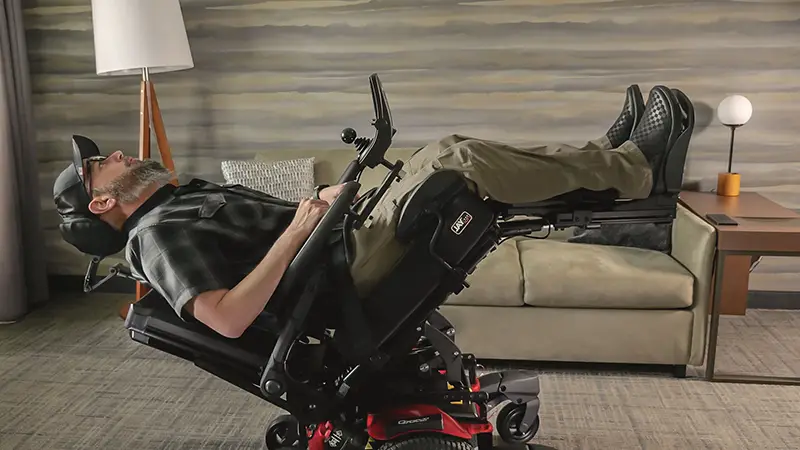The Switch-It CTRL+5's new voice activation feature adds a hands-free, intuitive way to change seating positions without switching modes or needing assistance. Voice activation can provide immediate and direct control of seat functions for people who benefit from position changes for pressure relief or pain control; positioning to avoid disruptive postural tendencies; and functional seat elevation for participation in MRADLs, transfers, or visual access. This allows for greater independence in managing seating needs without relying on assistance or switching modes. Voice activation can be a quicker, more responsive method of controlling seat functions as well as answering the phone. Clinical indicators include:
- Poor fine motor dexterity
- Muscle weakness in the fingers or thumbs
- Fatigue
- Tremors
- Upper extremity paralysis
- Decreased ability to consistently activate manual switches on the joystick controller
- Decreased ability to look down to visually see switches on the controller
- Inability to reach and activate switches on the joystick controller due to gravitational pull from recline or tilt
- Inability to easily or quickly access switches on the controller
- Functional changes throughout the day affecting fine motor strength and coordination
- Slow or inconsistent response time for activation of seat function changes
- Preference for voice activation
Diagnostically, this may include:
- People with tetraplegia or limited upper extremity movement may struggle to use switch controls and often find it tiring to navigate head switches for the frequent postural changes needed for pressure relief, stability, and participation.
- People with multiple sclerosis (MS) may have fluctuating abilities during the day due to fatigue or poor muscular endurance, making it difficult to consistently activate switches.
- People with Muscular Dystrophy (MD) or Spinal Muscular Atrophy (SMA) have progressive weakness that may limit reach & fine motor coordination, and decrease their ability to activate switches. As function deteriorates, they may need to continually adjust their position throughout the day to maintain their balance and manage postural tendencies.
- People with quadriplegic cerebral palsy typically have decreased coordination and inconsistent voluntary movement, which may make accessing switches difficult.
- People post-stroke with hemiplegia resulting in one-sided weakness may have difficulty operating a joystick or accessing small buttons. Perceptual and sensory deficits might make it difficult to accurately press the desired switch.
- People with ALS who have progressive weakness will often lose upper extremity function as the disease progresses. This may result in a loss of ability to use a joystick and access buttons or switches. Voice activation is compatible with AAC devices for voice impairment cases. For soft speakers, a lapel microphone can be added when using voice activation for power seat functions.
- People with bilateral upper extremity amputations lack the use of hands and fingers for control of the joystick or switches. Voice activation, along with head control, may be the fastest, most accurate method of control.
These are just a few examples of patient populations that may benefit from voice activation. However, anyone who has difficulty accessing switches due to deficits in strength, range of motion, motor control, or endurance could benefit from a direct way to access seat functions with voice activation.
Voice activation allows for quick changes to perfect positioning against gravity for functional participation with decreased pain and effort. Voice activation reduces the number of steps needed to access seat functions, resulting in increased efficiency and energy conservation.

Additionally, with memory seating on the SEDEO PRO ADVANCED seating system (Q700 M and Q700-UP M), CTRL+5 lets you move into your memory seat position using a single voice command. Recall positions like "pressure relief" or "transfer to bed" completely hands-free. Voice activation is now a standard feature on all newly ordered CTRL+5 switch boxes, providing people who have complex positioning needs with a quick and easy method to control all power seat functions on Sunrise Medical power wheelchairs.
With over 40 years of clinical practice as an OT, Jessica Presperin has worked in all sectors of the wheelchair and seating industry as a master clinician, supplier, manufacturing consultant, design representative, and educator. Dr. Presperin was a pioneer in the development of the profession of wheelchairs and seating in the 1980s and has spent the last two decades contributing to the research world to demonstrate evidence for knowledge translation in the clinic, advocacy, and product development. She is a RESNA and AOTA Fellow, serves on the Clinician Task Force, the Seating and Wheeled Mobility Committee for AOTA, and has shared her experiences internationally through publications and presentations.